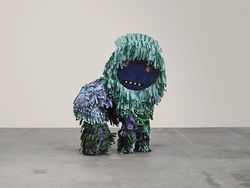Lion Dance Costume
| Design Year: | 2017 |
|---|---|
| Dimensions: | Wool, MDF, glass, LEDs |
| Materials: | Studio Produced commissioned by Kvadrat |
Lion Dance Costume was commissioned by Kvadrat for their My Canvas exhibition during London Design Festival 2017 at Somerset House. To celebrate the "Canvas" upholstery fabric designed by Giulio Ridolfo the design utilizes layered strips of fabric with frayed edges to display the individual fibers that comprise the fabric surface. The lion dance costume was chosen as the vehicle for the design to show movement and emphasize the lightness of the fibers.
Production
The idea to fray the fabric edge came as a response to the first concept which was to use the fabric as a replacement for fiberglass in the making of a boat. The resin hardening of the fabric caused the color to muddy and destroyed its beauty. In pulling the weave apart, the individual intensity of the warp and the weft threads could be displayed
Head
The head is built on a flat sheet of 1/4" thick MDF with rolls of fabric to create the surface of the face and rings of fringed fabric around the rim to create the mane. An arc of fabric covered polystyrene along the top edge create the upward support of the mane. The eyes are made of the same glass lenses and LED rings used on the Caviar Sconce to illuminate bao ding balls with a yin yang motif that was also used as tufting buttons on the banquets at Mission Chinese Food.
Cape
Inspiration for the cape came from Chinese jade burial suits and are comprised of layers of tiles made from polystyrene covered with fabric. Two hues of blue fabric were used to cover the tiles and two hues of green fabric were used to create the fringed tail sewn onto each tile. Tiles were individually attached to a sheet of green fabric in a layered pattern from the tail to the head and the edge was covered in layers of fringe.
Body and Legs
A simple apron like construction was used in three sections to create coverings for the body and legs of the 2 dancers under the cape. The body and the lower leg panels were made of layered fringe while the thigh coverings had the same tile construction as the cape.















